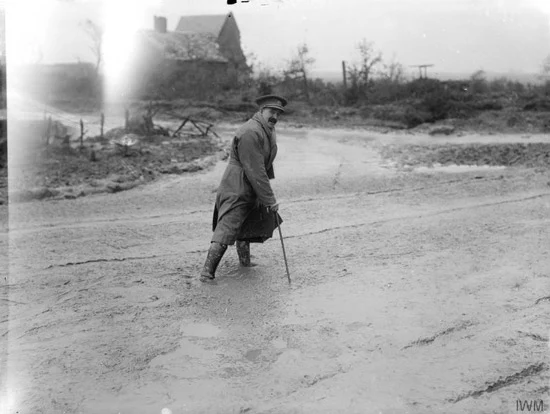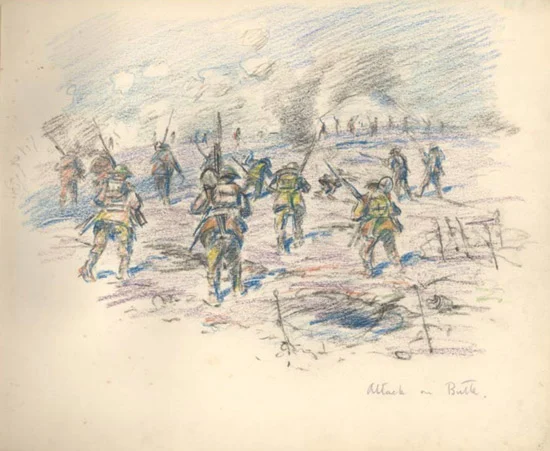On the First Day of the Somme:
- the British Fourth Army had 57,470 casualties, of whom 19,240 men were killed.
- The French had 1,590 casualties and
- the German 2nd Army lost 10,000–12,000 men.
This is about the way the battle was recorded at the time by those who drew - officially and otherwise - and the conditions that they found while they were there.
With the French and British armies calling upon troops from the colonies and the French Foreign Legion, units from 25 nations and 50 countries were involved in the Battle of the Somme. In five months of combat, the total number of men killed, wounded and missing reached over one million and entire nations were sent into mourning. Casualties amounted to 420,000 for the British, 190,000 for the French and 420,000 for the Germans. The landscape of the north-east of the Somme was completely devastated; villages were razed to the ground and fields were turned into lunar-landscapes by shelling. http://www.somme-battlefields.com/
Drawings of the Somme Battle and its aftermath
Those who drew varied. Some were or became famous. Others are little known. I'm guessing there are probably a fair few sketchbooks which never made it into official archives.
Those drawing the Somme include:
- Muirhead Bone (1876-1953)- the first official war artist. He became an active member of the War Artists' Advisory Committee in the Second World War. Bone was a draughtsman and etcher who had studied art in the evenings at the Glasgow School of Art and was a member of the New English Art Club.
- E H Shepard (1879-1976) - who subsequently provided illustrations for Winnie the Pooh and The Wind in the Willows
- George Hoffman Spencer - an architect and artist whose estate bequeathed his sketchbook to the Imperial War Museum. It contains some 150 drawings.
- Captain Robert Mauchlen (1885-1972) drew a series of sketches during the war, including several during the Battle of the Somme.
- J.B Morrall - A sketchbook of Morrall's drawings was sent in by Mrs Morrall (unclear whether this is the artist's wife or mother), and the Imperial War Museum purchased five of them
 |
| The war artist Lieutenant Muirhead Bone crossing a muddy road, Maricourt, September 1916 Imperial War Museum Collections |© IWM (Q 1464) |
Commissioned as an honorary second lieutenant, Bone served as a war artist with the Allied forces on the Western Front and also with the Royal Navy for a time. He arrived in France on 16 August 1916, during the Battle of the Somme and produced 150 drawings of the war before returning to England in October 1916. Wikipedia
George Spencer Hoffman drew the soldiers who were exhausted or wounded and killed in the battle.
Vignettes of soldiers on the Somme July 2016
First World War Sketchbook Volume 1 - Salvage, Somme, July 1916
George Spencer Hoffman (1875-1950)
Imperial War Museum Archive
EH Shepherd MC OBE (1879-1976) sketched his dugout in watercolour and the combat area around where he served.
Though in his mid-thirties when World War I broke out in 1914, Shepard received a commission as a second lieutenant in the Royal Garrison Artillery, an arm of the Royal Artillery. By 1916, Shepard started working for the Intelligence Department sketching the combat area within the view of his battery position. On 16 February 1917, he was made an acting captain whilst second-in-command of a siege battery, and briefly served as an acting major in late April and early May of that year, when he reverted to the acting rank of captain. He was promoted to lieutenant on 1 July 1917. Whilst acting as Captain, he was awarded the Military Cross for his service at the Battle of Passchendaele. Wikipedia
 |
| Our BC post copse B, near Maricourt Somme August 1916 E H Shepard Lieut. pencil and watercolour wash, 257mm c 180mm Imperial War Museum | Gift of Mrs E H Shepard, 1976 |
You can see more of EH Shepard's watercolour sketches from the First World War on the Imperial War Museum's website.
“Shepard went out to the Somme in June or July, and his brother, who he was close to, followed a couple of days later,” says curator Olivia Ahmad. “But he was killed almost instantly. When Shepard found out, he went to find his grave. He took a map with him and drew a tiny cross marking the co-ordinates where his brother was buried. All of the other maps he had were working documents, so they’re a bit tatty, but this one is pristine, with just this one tiny notation,” she adds.E.H. Shepard: An Illustrator’s War | Creative ReviewSome were adept at sketching soldiers in action. This is a very impressive sketch by Captain Robert Mauchlen MC (1885-1972)
 |
| Sketch of the attack on the Butte de Warlencourt on 5 November 1916 by Captain Robert Mauchlen MC (1885-1972) Sketchbook in the Battle of the Somme archives of Durham County Record Office |
The Butte de Warlencourt is an ancient burial mound off the Albert–Bapaume road, north-east of Le Sars in the Somme département of northern France. .....The Germans constructed deep dugouts throughout the Butte and surrounded it by several belts of barbed wire, making it a formidable defensive position in advance of Gallwitz Riegel (the Gird Trenches). After the Battle of Flers–Courcelette (15–22 September) the view from the Butte dominated the new British front line and was used by the Germans for artillery observation. During the Battle of Le Transloy (1–20 October), part of the Battle of the Somme, the Butte de Warlencourt was the subject of several attacks by the British Fourth Army, which were costly failures; attacks in November also failed. WikipediaThe artillery shelling reduced everything to nothing. This is an article about How War Artist Muirhead Bone Recorded The Battle of The Somme
 |
| An Artillery Barrage on the Somme Battlefield: Mametz Wood, Contalmaison Château, Fricourt Wood and Delville Wood in the distance. Drawn from King's Hill, Fricourt, September, 1916 Muirhead Bone pencil and wash 330mm x 501mm Imperial War Museum Collection | Art.IWM ART 2098 |
Villages, trees and people were all obliterated - and the artists continued to sketch and record.
Contalmaison was a village which was a target on the very first day - on 1st July 2016
Contalmaison can be found about three miles north-east of Albert and around half a mile south of Pozieres, on the southern side of the main D929 road. The village was an objective for the 34th Division on the 1st of July 1916, but it took many more days of hard fighting before the 8th and 9th Green Howards of the 23rd Division were able to take it at 4.30 p.m. on the 10th of July.
World War One Battlefields
 |
| Contalmaison in 1916 : the remains of the village J. B. Morrall |
a view across the devastated village of Contalmaison, which has been reduced to piles of rubble and tree stumps, with only a single recognisable building visible.
(IWM)
 |
'The abomination of desolation'
Mametz Wood: after the autumn advance, 1916.
J. B. Morrall
watercolour on paper, 228 mm x 286 mm
Imperial War Museum Collection | © IWM (Art.IWM ART 202)
|
a view across the devastated Mametz Wood, with splintered tree stumps and flooded shell holes. The body of a dead German infantryman lies in the foreground, the legs visible but the torso and head hidden by the water of a flooded shell hole.
(IWM)
Then the wounded were brought home - first embarking on the ships. This is a lithograph by Muirhead Bone of the embarkation of the wounded which would have been based on sketchbook studies at the time. Muirhead Bone created a portfolio of 60 prints at the end of the war based on studies made while working as a war artist.
 |
| War Drawings By Muirhead Bone: Taking the Wounded lithograph on paper; 505mm x 378mm |
Then they return home via London.
This is the view I have of Charing Cross Station every time I return home from a visit to the National Gallery or National Portrait Gallery. It's therefore especially poignant to realise the function the station also played in bringing home the wounded from the Battle of the Somme. (The painting below was painted the year after the war finished.)
A view of the exterior of Charing Cross railway station. The Strand is lined with crowds of civilians watching Red Cross ambulances leaving the station.
 |
| Outside Charing Cross Station, July 1916. Casualties from the Battle of the Somme arriving in London J Hobson Lobley 1919 oil on vanvas, 2057mm x 3073mm Imperial War Museum Collection © IWM (Art.IWM ART 2759) |
There's something very special about recording an event which you witnessed.
There's also something very special about maintaining an archive - and then sharing it and allowing others to share so that others can see what went before....
See also
- my earlier blog post about the 2013 exhibition 'Stanley Spencer: Heaven in a Hell of War' at Somerset House
- the British Library article Why paint war? British and Belgian artists in World War One -Article by: Paul Gough

Fascinating article on some great war artists , for me one of the best First World War artist/ illustrators was Fortunino Matania wonderful artist , if it would have been possible to post some his examples I would have done.
ReplyDelete